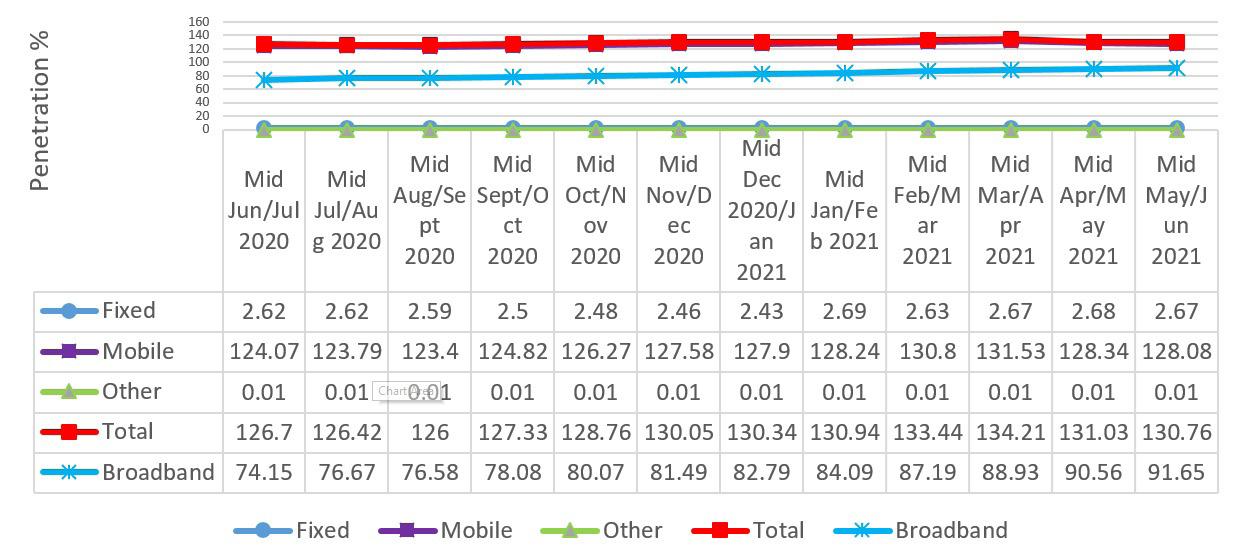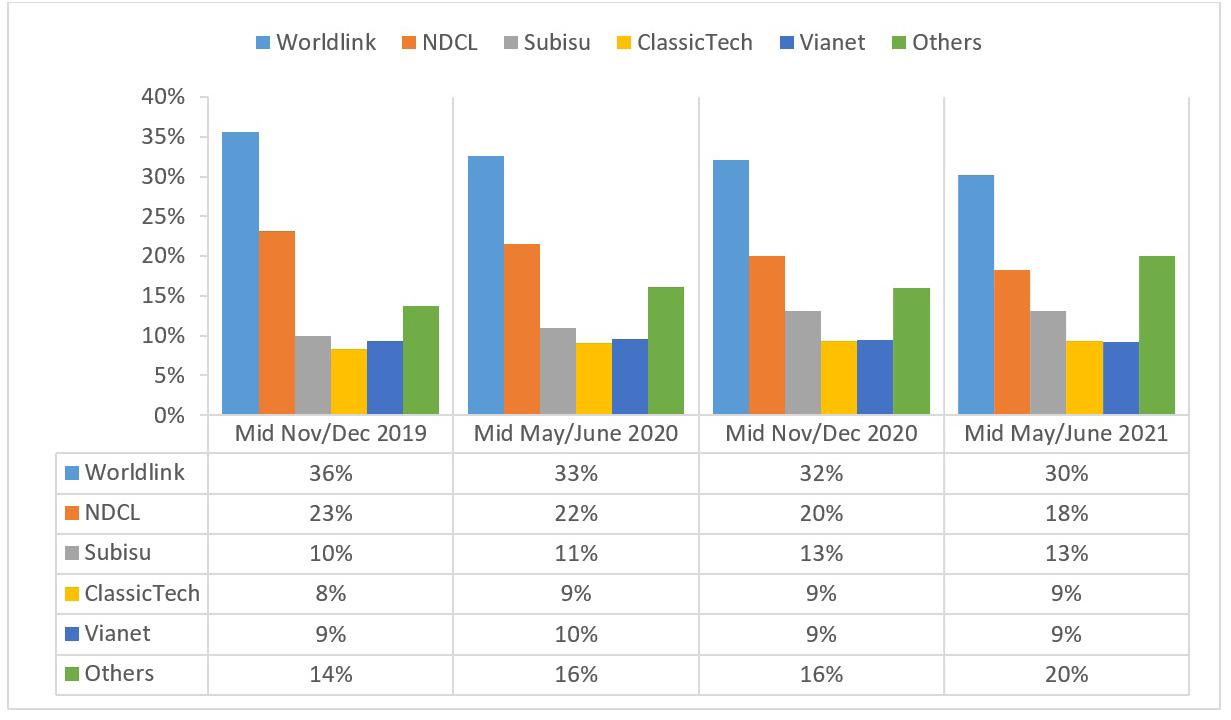
9 minute read
Information and Communication Technology
INFORMATION AND INFORMATION AND COMMUNICATION TECHNOLOGY COMMUNICATION TECHNOLOGY
The importance of telecommunications infrastructure for the economy has heightened from the start of the COVID-19 pandemic. With the increase in internet and mobile users, Government of Nepal has taken many initiatives to ensure the affordable and reliable reach of internet through telecommunications infrastructure. The private sector of Information and Communication Technology (ICT) has leaped into action to take advantage of this very lucrative market.
Advertisement
Shared use of Telecommunications
infrastructure: Nepal Telecommunication Authority (NTA) has approved regulations related to the shared use of telecommunication infrastructure such as towers and fiber networks. Two or more telecommunication service providers can agree among themselves to use the telecommunication infrastructure mutually but will need to inform NTA within 15 days of the agreement. Every service provider is required to publish detailed information about the telecommunication infrastructure, which can be shared on their official website, and update it monthly. A maximum charge for infrastructure sharing will be determined by the authority and the service provider is required to share the details of the charges whenever asked.
With the approval of the regulations, telecommunication and internet service providers will no longer have to invest heavily in infrastructure, easing their financial burden and bringing down costs. This policy is expected to enhance coverage and network quality by increasing internet penetration of stable connections. This is expected to create a fair and healthy competition in the market.200
Directives for testing of new
technology: Several directives have been issued by NTA for the testing of new technology including 5G. This covers network construction, trial period, frequency charges, and service charges. The directive states that a service provider should submit an action plan to the authority regarding the modalities of possible testing of the new technology, its information, locations to be tested, services to be provided, and its process. Similarly, details of frequency required for testing (band, bandwidth, reason to use band, and basis for bandwidth consumption), network connection, and operating schedule should also be disclosed by the service provider in the action plan. Both rural and urban areas need to be included while testing such technology.201 The import of equipment required to test new technology will be facilitated by NTA. The trial period for 5G testing is one year, where NTA will waive the frequency fee as well as prohibit the service provider from charging fees to the customer in areas where 5G is available.202
Chaudhary Group launches Fiber
Net in Nepal: CG Net, a part of Chaudhary Group, has launched its fiber internet services. Initially available only in few places of Lalitpur, it is quickly expanding its services and is now available in more than 20 places within Kathmandu Valley. It has plans of widening its coverage to major cities of Nepal within this year. CG Net introduced the highest bandwidth speed at the lowest available cost, which is 120Mbps at NPR 999 (USD 8.38) per month.203
Optical Fibre Backbone Network
Expansion Project: The Optical Fibre Backbone Network Expansion Project, which was launched in 2016, has completed 46.16% of the work till July 15, 2021, laying optical fiber cables along 1600 km length. This project was divided and assigned to Nepal Telecom, Smart Telecom, and United Telecom (UTL). Nepal Telecom has made the most progress so far by installing optical fiber cable in 1006 km out of 2,083 km it had been assigned. The contract with UTL was annulled due to their failure to commence the project within the given period. Smart Telecom has so far laid out only 20 km of the 2500 km it had been assigned. 204
This project is expected to encourage the expansion of broadband internet
services across the country. With the completion of this project, telecom operators can use these cables instead of investing in their own cables. This will make internet cheaper and thus more accessible all over the country.205
Nepal ranks 94th in Global
Cybersecurity ranking: Nepal scored 44.99 points out of 100, ranking 94th in the Global Cybersecurity Index 2020 out of 182 countries, an improvement from the 106th position in 2018. Nepal secured 15.61 points in legal measure, 5.94 in technical measures, 9.58 in organizational measures, 9.6 in capacity development, and 4.26 in cooperative measures. An increase in digital transactions in Nepal has created a need for investment in cybersecurity infrastructure. Nepal Telecom Authority’s Cyber Security Bylaw 2020 is being implemented. Ministry of Communication and Information Technology has drafted a National Cyber Security Policy 2021 to control and prevent cybersecurity attacks.206
Digital payments decrease as the
country re-opens: As the country eased lockdown restrictions, various means of electronic payment showed a decline in transaction volume. The Interbank Payment System (IPS) recorded 855,522 transactions worth NPR 144 billion (USD 1.21 billion) from mid-May 2021 to mid-June 2021. Digital payments dropped 12% to NPR 276.43 billion (USD 2.32 billion) in the period compared to the previous month. Transactions worth NPR 8.35 billion (USD 70.1 million) occurred through digital wallets in the same period, a decrease of 17% from the previous month. Similarly, Quick Response (QR) based payments were worth NPR 1.96 billion (USD 16.45 million) in the period, a 22% decline from previous month. E-commerce transactions through cards dropped by a staggering 79% from previous month to NPR 161 million (USD 1.35 million). This can be attributed to easy access to cash after lockdown was eased, showing a strong preference for cash transactions by Nepali people.207
FY 2021/22 declared as “Electronic
Transaction Promotion Year”: Nepal Rastra Bank (NRB), Nepal’s central bank, declared Fiscal Year (FY) 2021/22 as “Electronic Transaction Promotion Year”. The bank is focused on developing necessary infrastructure to interlink digital payment tools and establish a national payment gateway to introduce payment cards. A review of transaction limit set for digital payment tools will be conducted along with reducing the tariffs imposed on digital transactions. It will also facilitate government agencies to receive money via electronic payments, with plans to enable social security payments through electronic transaction systems.208
Increasing access to telecommunication and data:
The tele-density of the country was recorded by NTA to be 130.7% with 806,047 fixed line subscribers (2.7%) and 38.7 million mobile subscribers (128%). The number of internet data subscribers stood at 27.7 million. The internet penetration rate as of midJune was 91.65%. As shown in Figure 1, the internet penetration has been largely driven by mobile broadband services, which account for 65.68% of the total internet penetration, and fixed broadband (wired and wireless), which contributes to 25.98%.
Figure 11. Growth Trend of Voice telephone and data service penetration
Figure 12. Telecom Operators Market Share
Figure 13. Market share of Internet Service Providers in Nepal over two years

Note: NDCL stands for Nepal Doorsanchar Company Limited, and STPL stands for Smart Telecom Private limited.

Note: NDCL stands for Nepal Doorsanchar Company Limited.
OUTLOOK
Telecommunication infrastructure sharing directives have been demanded for a long time by the country’s Internet Service Providers (ISPs). Sharing of telecommunications infrastructure will reduce the number of towers and their energy requirement. The service providers who own the infrastructure will benefit from an additional source of revenue, thus increasing their return on the telecommunications asset. The savings made by organizations on investment in infrastructure can be utilized to increase resources for the faster rollout of new technologies. The load bearing capacity of the already existing infrastructure might not be capable of handling extra load, which might make them unsuitable for sharing. The benefit received by the end consumer depends on whether the service provider choose to pass their cost saving on to consumers in the form of reduced prices. The likelihood of this happening is small as such savings are retained by the service providers, except in cases of high competition. One of the main disadvantages of infrastructure sharing is that the owner of the infrastructure will not have full control over its network strategies anymore, discouraging construction of infrastructure in new areas.209
The directives issued by NTA for the testing of new technology will fast track the adoption of 5G in Nepal. The expected speed of 5G is 100 times more than 4G, with latency 10 times lower than in 4G. 5G has 1,000 times more capacity than 4G, which will greatly help in the development of Internet of Things.210 Due to these features, new automation, and Artificial Intelligence (AI) technologies will flourish. 5G has enormous potential in the automation of manufacturing industries, such as process automation, component tracking, etc. However, 5G’s impact in Nepali manufacturing industry may be limited due to unorganized and informal workforce, and manufacturing representing only 11.8% of GDP.211 Since 5G uses shorter wavelengths than 3G or 4G, it will need an increased number of towers to be able to reach everywhere. 5G connection could be easily obstructed in a country like Nepal where even 3G and 4G connections are not available conveniently at all locations; the proportion of population who will benefit from 5G seems to be limited. Existing network towers may not be compatible with 5G, which will further increase the set-up cost. A cost-benefit analysis needs to be carried out to see whether the high costs of setting up 5G networks will be offset by the benefits received in the form of increased business activities and improved communication.
With CG Net’s debut, the landscape of ISPs could change due to increased competition; to maintain their customer base, ISPs have already made some changes to their offered packages. DishHome introduced the cheapest 25Mbps fiber net at NPR 233 (USD 1.95) per month for its premium customers. Similarly, Subisu launched a 150Mbps fiber internet package at NPR 2360 (USD 19.81) per month, becoming the highest speed offered by ISPs in Nepal.212
The FY 2021/22, which is being promoted as a “Electronic Transaction Promotion Year”, is expected to provide further momentum to the increasing trend of digital transactions in Nepal. Electronic transactions worth NPR 163.87 billion (USD 1.37 billion) were made through mediums such as ConnectIPS, mobile and internet banking, and QR codes in the month ending in mid-February 2021, representing a 7% increase from the previous month. ConnectIPS represented nearly 64% of these transactions.213 Despite the transaction volume across digital payment platforms falling as the country re-opened from the pandemic, with proper initiatives from the government and the private sector, this trend can still be maintained. With the internet penetration reaching 91.65%, people all over the country have increasing access to the benefits of digital payments such as increased efficiency and ease of transaction. Awareness campaigns to promote digital payment platforms and financial literacy can be conducted, especially outside Kathmandu Valley where use of digital payment is low. The preference for cash and doubts regarding the security of digital payments in Nepal will change slowly as people start to get used to the ease of digital payments. Growth in financial technology (fintech) companies in the country and government efforts such as the “Electronic Transaction Promotion Year” will ease Nepal’s transition into a cashless economy.




